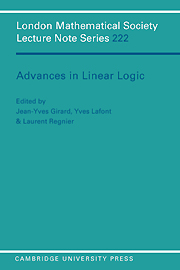Book contents
- Frontmatter
- Contents
- Preface
- Linear Logic: its syntax and semantics
- Part I Categories and semantics
- Bilinear logic in algebra, and linguistics
- A category arising in linear logic, complexity theory and set theory
- Hypercoherences: a strongly stable model of linear logic
- Part II Complexity and expressivity
- Part III Proof theory
- Part IV Proof nets
- Part V Geometry of interaction
Bilinear logic in algebra, and linguistics
Published online by Cambridge University Press: 17 February 2010
- Frontmatter
- Contents
- Preface
- Linear Logic: its syntax and semantics
- Part I Categories and semantics
- Bilinear logic in algebra, and linguistics
- A category arising in linear logic, complexity theory and set theory
- Hypercoherences: a strongly stable model of linear logic
- Part II Complexity and expressivity
- Part III Proof theory
- Part IV Proof nets
- Part V Geometry of interaction
Summary
Abstract
The syntactic calculus, a fragment of noncommutative linear logic, was introduced in 1958 because of its hoped for linguistic application. Working with a Gentzen style presentation, one was led to the problem of finding all derivations f : A1 … An → B in the free syntactic calculus generated by a context free grammar g (with arrows reversed) and to the problem of determining all equations f = g between two such derivations. The first problem was solved by showing that f is equal to a derivation in normal form, whose construction involves no identity arrows and no cuts (except those in g) and the second problem is solved by reducing both f and g to normal form.
The original motivation for the syntactic calculus came from multilinear algebra and a categorical semantics was given by the calculus of bimodules. Bimodules RFS may be viewed as additive functors R → Mod S, where R and S are rings (of several objects). It is now clear that Lawvere's generalized bimodules will also provide a semantics for what may be called labeled bilinear logic.
Introduction.
I was asked to talk about one precursor of linear logic that I happened to be involved in, even though it anticipated only a small fraction of what goes on in the linear logic enterprise. I would now call this system “bilinear logic”, meaning “non-commutative linear logic” or “logic without Gentzen's three structural rules”.
- Type
- Chapter
- Information
- Advances in Linear Logic , pp. 43 - 60Publisher: Cambridge University PressPrint publication year: 1995
- 6
- Cited by



